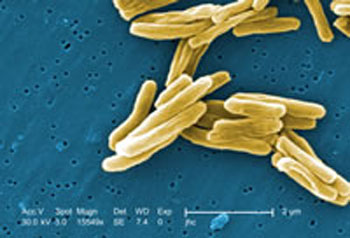Drugs That Block Sulfur Metabolism Show Potential for Treating Latent Tuberculosis
By LabMedica International staff writers
Posted on 14 Dec 2015
Drugs that target sulfur metabolism have been found to have potential for treating latent tuberculosis infections, including those caused by drug-resistant forms of the bacteria.Posted on 14 Dec 2015
Sulfur metabolism is genetically and pharmacologically implicated in survival, pathogenesis, and redox homeostasis of persistent Mycobacterium tuberculosis (Mtb). Therefore, inhibitors of this pathway are expected to serve as powerful tools for eradicating persistent, latent Mtb infection.

Image: Colorized scanning electron micrograph (SEM) of the ultrastructural details seen in the cell wall configuration of a number of Gram-positive Mycobacterium tuberculosis bacteria (Photo courtesy of the CDC - US Centers for Disease Control and Prevention).
Investigators at the Scripps Research Institute (Jupiter, FL, USA) and colleagues at the Indian Institute of Science (Bangalore, India) established a first functional high-throughput screening platform for identification of adenosine 5’-phosphosulfate reductase (APSR) inhibitors, a critical enzyme in the assimilation of sulfate for the biosynthesis of cysteine and other essential sulfur-containing molecules.
They reported in the November 2, 2015, online edition of the journal ACS Chemical Biology that after screening 38,350 compounds they had discovered three distinct structural classes of APSR inhibitors. A class of bioactive compounds with known pharmacology displayed potent bactericidal activity in wild-type Mtb as well as multidrug resistant (MDR) and extensively drug-resistant (XDR) clinical isolates.
“M. tuberculosis infects host macrophages,” said senior author Dr. Kate Carroll, an associate professor at the Scripps Research Institute. “These immune cells produce high levels of reactive oxygen and reactive nitrogen species (RONS), which cause oxidative damage to biomolecules, such as lipids, proteins, and DNA. For this reason, M. tuberculosis depends heavily upon the production of RONS-neutralizing reduced sulfur compounds, including mycothiol and cysteine. This is why the reductive sulfur assimilation pathway is such a powerful target. Once you reduce the level of reduced sulfur compounds, you eliminate a central mechanism that all bacteria, including M. tuberculosis, use to survive host defense systems.”
“With the help of Scripps Florida’s high-throughput screening facility, we looked at nearly 40,000 compounds before we uncovered these new, potent inhibitors that attack an enzyme critical to the survival of persistent tuberculosis,” said Dr. Carroll. “Thanks to our collaborators in India with access to drug-resistant patient isolates, we were able to demonstrate that these compounds also show excellent activity against multidrug resistant (MDR) and extensively drug-resistant (XDR) strains, in addition to the standard laboratory reference strain, H37Rv, of M. tuberculosis.”
Related Links:
Scripps Research Institute
Indian Institute of Science













